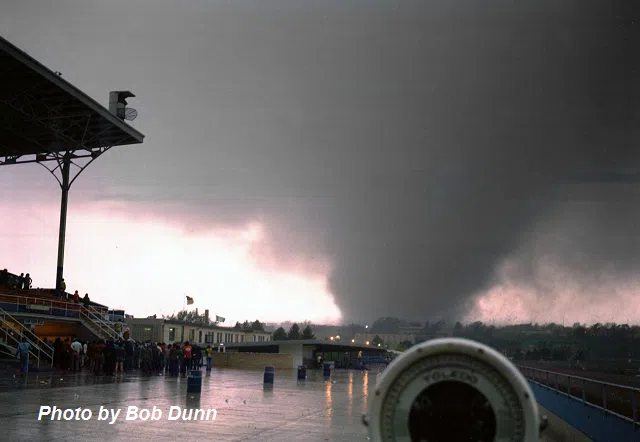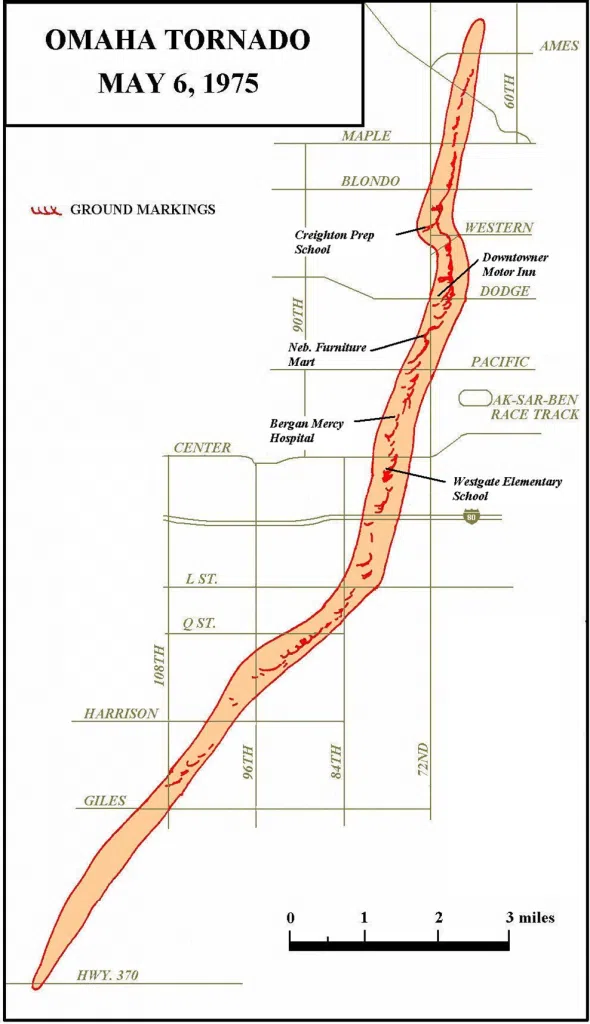
This photo of the Omaha Tornado was taken near Aksarben (72nd and Mercy Rd.) by Bob Dunn, (Courtesy of NWS Omaha/Valley)
OMAHA — Today marks the 50th anniversary of the 1975 tornado outbreak that occurred in the upper Midwest, the costliest of which was an F4 tornado that stuck Omaha directly and killed three people.
The Omaha tornado was at the time the costliest in U.S. history at $150 million, damaging over a thousand homes over a 2,000-block area on its 15-mile-long path.
The tornado outbreak was associated with an intense area of low pressure that moves from Colorado into South Dakota that moved in combination with an upper-level trough.
The National Severe Storms Forecast Center (NSSFC) issued a tornado watch for much of the area in advance of the event at 12:37 p.m. May 6.
At around 1:15 p.m., the National Weather Service office in Omaha received a report of hail from Creigton, the office’s first of the day. The thunderstorms were supported by the channel of moist air, tracking north before eventually weakening after moving into cooler and drier air downwind.
Twelve tornadoes ultimately occurred over the north-central Great Plains on May 6, with large and strong tornadoes affecting eastern Nebraska.
The other strongest tornado of the day was another F4 tornado that directly struck the Nebraska community of Magnet, nearly every structure in town was damaged or destroyed. Magnet city hall was destroyed and some cars were thrown over 200 yards.
Meteorologist Ted Fujita, who later photographed cycloidal scar patterns left by the tornado in cornfields in Cedar and Pierce counties, estimated that the tornado that struck Magnet was stronger than the Omaha tornado.
Teams of storm spotters associated with the National Weather Service and Offutt Air Force Base were deployed following the watch and warning issuances between around 1–2 p.m. At 4:09 p.m., a volunteer storm spotter reported an emerging funnel cloud northwest of Springfield, Nebraska. Tornado sirens were activated for Sarpy County, Nebraska, following the report, according to an article published by the Omaha World-Herald.
The Omaha tornado touched down at 4:33 p.m. in the largely rural area near the intersection of Highway 370 in Sarpy County. The first homes destroyed by the tornado were hit at around 4:35 p.m.
Moving northeast, the tornado struck parts of northwestern Ralston, damaging neighborhoods and businesses near 84th and L streets. Large airborne debris was observed near 72nd and L streets.
It was reported that 2x4s were reported falling from the sky over Omaha ahead of the tornado, according to research article published in the Bulletin of the American Meteorological Society.
The Wentworth Apartments, the largest apartment complex in the Omaha area at the time, sustained severe damage with 70 percent of the complex’s buildings destroyed.
The tornados path then curved north towards and over west-central sections of the city of Omaha, crossing Interstate 80 near 84th Street, inflicting injuries on the highway and prompting the highway’s closure.
Near the Westgate subdivision, the tornado caused extensive damage and destroyed the Westgate Elementary School. Numerous buildings sustained significant damage near the intersection of 72nd and Dodge streets, including the Nebraska Furniture Mart.
Most of the mail carrier fleet at a nearby U.S. post office was lost, with 80 of the office’s 90 cars destroyed. Some of the most severe damage associated with the tornado occurred after it crossed Dodge Street at around 4:45 p.m., with buildings reduced to rubble.
Two people were killed near the intersection of 69th and Maple streets. Three people would be killed by the tornado and another 141 people were injured; of the injuries, 25 were considered serious injuries.
Across the roughly 2,000-block area affected by the tornado, 287 homes were destroyed, 650 were heavily damaged, and 787 were moderately damaged; another 53 apartment buildings sustained damage. The damage made thousands of people homeless.
The Nebraska governor’s office estimated a damage toll of $150–200 million (equivalent to $0.9–1.2 billion today), making the tornado the costliest tornado in U.S. history and the costliest natural disaster in Nebraska history at the time.

Track of the 1975 tornado, (NWS Omaha/Valley, Courtesy)


